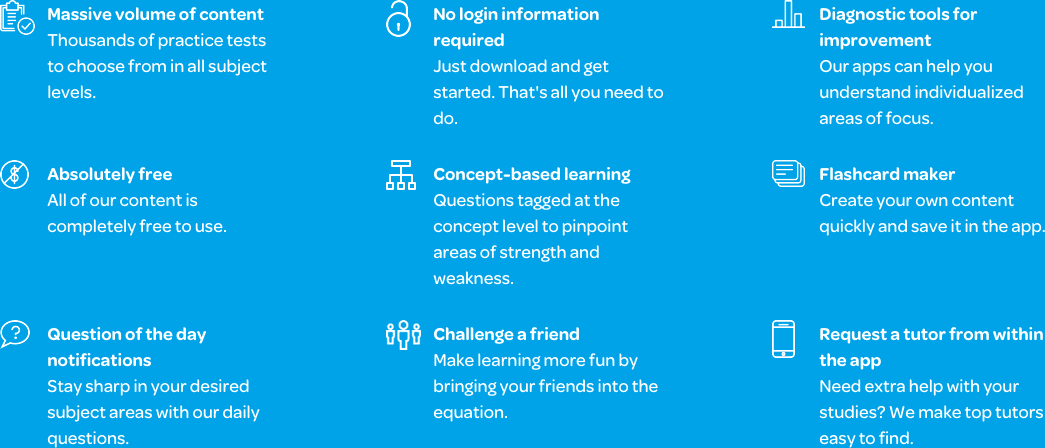The Varsity Tutors High School Biology Mobile App
Most high school students have typically had some experience in the subject of biology. However, it may be your first time exploring tissues, microbiology, organ systems, and other concepts. Through the free Varsity Tutors High School Biology app, you are able to get access to study materials on your Android or Apple devices. There are practice tests, flashcards, and review materials that are designed to help you learn and retain the information you need for any tests in biology.
Using the app, you can opt to focus your studies on specific biological areas or test and review them overall, from DNA to cell division. There are numerous principles covered by the app, including:
-Cell division, such as the stages of cell division, the cell cycle, and cell cycle regulation
-Cell functions, like cell respiration, photosynthesis, and proteins
-Cell structures, including common cell structures in both plant and prokaryotic cells
-A look at the replication processes, structures, and functions of RNA, DNA, and proteins
-Ecology, such as chemical cycles, the food pyramid, and understanding energy flow
-Genetic and evolutionary principles, like natural selection, speciation, gene coding, and inheritance patterns
-Macromolecules, homeostasis, and tissues, organs, and organ systems
-And many others.
Through the practice exams, you can assess your knowledge in various core concepts of biology. Whether you take a concept-specific exam or a full-length practice test, you will receive detailed results for each question that includes information such as relevant concepts, detailed explanations, the time it took you to solve each question, and more. You can use these to identify the areas in which you may need more work. It has never been so easy to streamline your study sessions!
For additional practice, you can use the Learn by Concept tool. This offers a full-course breakdown of each concept you will work with. You are given a full set of practice questions with detailed explanations of each answer. In addition, the tool provides an analysis of your progress throughout the test review. With the resources offered by the app, you can take advantage of any spare time during your day to get some studying in, review, or test yourself on various concepts.
You can also study using the app’s pre-made flashcards, which cover all of the above-mentioned concepts. The flashcards offered on the high school biology app are versatile. You can remove any concepts you don’t need to practice, or use them all for a fast-paced, comprehensive review before tests. Flashcards are ideal for those who may be too busy for a sit-down study session and are also great when used with a study group or partner. If you need to work more on a particular concept, you can use the Flashcard Maker to create custom cards from your own classwork.
You can use the app all throughout the school year to keep your mind sharp and prepared for anything high school biology might throw at you. Prepare for upcoming unit tests or the final with the adaptive and easy-to-use Varsity Tutors High School Biology app, available from iTunes or the Google Play Store.
66 mobile apps to choose from for your tutoring needs.

Learn More
High School Biology is a crucial foundation course for students who think they may go on to study more advanced sciences during or after high school. Biology is the study of life and living organisms. The primary concepts you will be taught involve cells, genes, evolution, organ systems, and the processes organisms use to ensure survival. Your class may also touch upon biochemistry, molecular biology, botany, cellular biology, physiology, evolutionary biology, or ecology. These sub-disciplines are all rooted in biology. Your future success in classes focused on these sub-disciplines will depend on your mastery of the concepts you will learn in high school biology.
The first unit of high school biology will help you to become familiar with the attributes of life. You’ll review the requirements for life, and the properties of carbon and water. You will then dive into cell biology. Cells are known as the basic building blocks of life, and as all living things are made up of either cells or products of cells, you will need to have a strong grasp of their processes. Cells also play a part in metabolism, and are the carriers of genetic information such as DNA. In this unit, you will learn about cell division, functions, structures, and organelles.
You will need to understand the structure of and differences among various types of cells, like plant cells and prokaryotic cells. Mastering cell structure is also important, and you’ll become familiar with mitochondria, chloroplasts, ribosomes, cell membranes and walls, endoplasmic reticulum, and the nucleus and nucleolus. Cell division takes part in one of two ways: mitosis or meiosis. Mitosis involves a gender-neutral process known as the cell cycle, which is a series of phases the cell goes through as it divides. Meiosis is a gender-specific, two-phase process of cell division. You will also learn about cell functions, like respiration, photosynthesis, transport, and signaling.
High school biology classes frequently include a section on ecology. Ecology deals with organisms’ relationships to each other and their interactions with their surroundings. In the ecology unit, you’ll study chemical cycles, including the water, carbon, and nitrogen cycles. You will also learn about food pyramids and webs, and how to determine an organism’s level within these structures. The ecology unit will review energy principles, like the process through which organisms extract energy from their foods.
Then, you will move on to study tissues, organs, and the organ systems. You will study the properties and types of connective, muscle, and nervous tissues, along with the properties of epithelium and the three types of epithelial cells. Once you have a grasp on the functions and traits of tissues, you can apply this knowledge to the organs and organ systems. You’ll be taught about the organ systems from head to toe: the circulatory, musculoskeletal, nervous, and respiratory systems are covered first. Then, you’ll get into the digestive, excretory, and reproductive systems. Finally, you will learn about the endocrine and immune systems. The lessons on these systems will also include a full overview of the organs involved in each process.
After mastering cell biology, tissues, and organ systems, you’ll move into a unit on DNA, RNA, and proteins. You’ll study up on DNA’s structure and elements, including chromosomes, genes, nucleotides, the DNA backbone, and the classic double helix structure. Then, the course will explore DNA replication. You’ll learn about its proteins, processes, and regulation. You’ll also learn about the structural differences between DNA and RNA, and RNA’s transcription processes. This unit will also include information on proteins, like enzymes and inhibitors. You’ll study their structure and classifications, specific functions, and translation processes. It’s essential to not just memorize the information in this section, but also to truly understand it. The basic concepts you will master on DNA and RNA now will help you immensely when your class moves into genetics and evolution.
Genetics and evolution are frequently seen as the most complex of all high school biology concepts. You will use all of the information you have already encountered in this course as you work toward mastering the principles in this section. Evolution examines the changes in genetic traits over a period of time. You will begin the unit by reviewing the evidence for evolution and concepts related to biological fitness, phylogenetics, and speciation. During the evolution unit, your class will learn about Charles Darwin. Darwin’s observations in “On the Origin of Species” may be required reading. You will cover Darwin’s theory of biological evolution, which states that all organisms develop through small variations that increase the organism’s ability to survive and reproduce. This is known as natural selection, and it’s one of many evolutionary concepts you will be taught.
Genetics focuses on living organisms’ genes, genetic variations, and heredity. You’ll be taught how genes and DNA interact with one another, and gene coding, regulation, and prokaryotic genes will be reviewed. You’ll also learn the principles of the Hardy-Weinberg equilibrium, how to calculate it, and the conditions that affect it. Then, you’ll review inheritance patterns. You’ll need a thorough understanding of chromosomes, particularly of how they are structured. You’ll need to understand codominance, incomplete dominance, and the difference and interaction between dominant and recessive genes. This unit is where you may encounter the Punnett square, the diagram that predicts the results of a breeding experiment. You’ll also explore autosomal and sex-linked principles of inheritance. Finally, you’ll be taught about genetic mutations, like DNA substitutions, insertions, and deletions.
Your success in high school biology will not be dependent upon memorization of facts. Instead, it will be necessary for you to exercise your skills in critical thinking; being able to recognize the most important facts, work methodically through challenging problems, and apply your knowledge to new scenarios will be crucial skills. The wide variety of new concepts you’ll encounter in this course can seem overwhelming, so it’s essential to stay on top of your coursework. By studying regularly and making sure you understand each lesson thoroughly before you move onto the next, you can build a solid foundation for your upper-level science courses.




